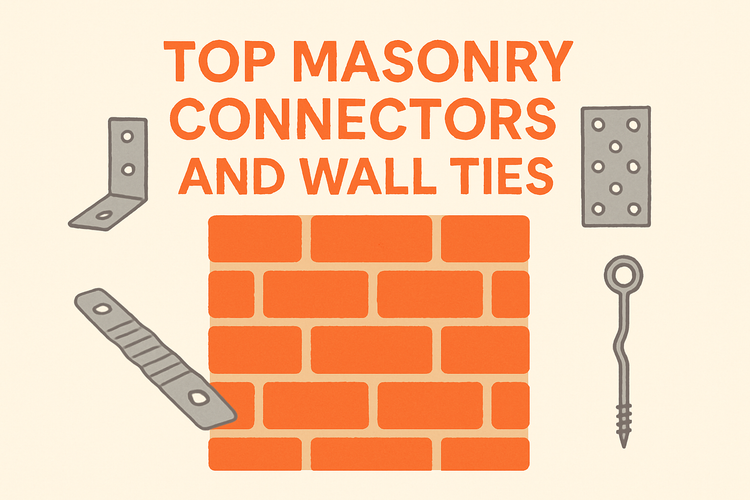Top Masonry Connectors And Wall Ties

Understanding the Role of Masonry Connectors and Wall Ties
Masonry connectors and wall ties are essential components in structural masonry work. They provide critical support and stability by linking different masonry elements together or anchoring them to various structural materials.
These connectors not only improve the integrity of a structure but also help it withstand dynamic forces such as wind loads and seismic movements. By ensuring proper distribution of stress, masonry connectors reduce the likelihood of structural cracks or failure over time. Their quality and correct installation are vital in both domestic and commercial construction projects.
Durability is a central feature of these connectors. Galvanized or stainless-steel materials are commonly used, offering corrosion resistance and long-lasting performance. Whether you're undertaking a new build or a renovation, choosing the right type of wall ties and masonry connectors is crucial for long-term structural health.
Types of Masonry Connectors and Their Applications
There are several types of masonry connectors, each designed for specific load requirements and wall configurations.
Cavity wall ties, for instance, are used to bind the inner and outer leaves of a cavity wall together. These are especially important for maintaining stability under wind loads and ensuring the leaves act simultaneously when subjected to stress. Movement ties, on the other hand, are flexible and allow for independent wall movement to prevent cracking in long walls or walls subject to thermal expansion.
Profiles such as wall starter kits work well for extensions and new wall applications where an existing structure needs to be securely connected to new masonry elements. Ties for timber-frame structures differ in design and are used to connect timber frames to brick or block walls, ensuring inter-material stability.
Understanding the correct type of masonry connector to use is not only beneficial to the longevity of a structure but also essential for meeting building code regulations. To explore more masonry-specific options, visit our selection of Masonry Connectors and Wall Ties.
Best Practices for Installing Wall Ties in Masonry Construction
Installing wall ties correctly is just as important as selecting the right type. Poor installation can severely compromise a structure’s stability and lifespan.
Wall ties should be placed at even intervals both horizontally and vertically to distribute loads uniformly across the wall. This standard spacing – often 450mm vertically and 900mm horizontally – ensures a balanced load-sharing network across the cavity. Additional ties should be inserted around all openings such as doors and windows to counteract stress concentrations that may arise in these vulnerable areas.
Orientation also plays a critical role. Wall ties must be installed with a slight upward tilt to prevent moisture from penetrating to the inner wall, a common oversight that leads to damp issues. The embedding depth into each leaf of the wall should be at least 50mm for optimal stability.
Finally, during the laying of bricks or blocks, ensure wall ties are clean and free of mortar droppings, which can prevent proper embedment or cause thermal bridging. For additional robust fasteners, pairing ties with components from our Screws and Nails range can ensure a secure fit.
Advantages of Stainless Steel Wall Ties in Harsh Environments
Stainless steel wall ties are frequently recommended for structures located in coastal zones, industrial regions, or high-moisture environments.
The primary benefit lies in their resistance to corrosion. Unlike galvanized wall ties that risk oxide build-up after prolonged exposure to moisture and air, stainless steel ties maintain structural integrity over time. This reduces the likelihood of internal wall damage, insulating failure, and long-term decay of the surrounding masonry work.
Moreover, stainless steel is non-reactive in composite structures, making it suitable for use with dissimilar materials like timber or reinforced steel frames. Combined usage with supports such as Post Base connectors offers a versatile mounting solution in hybrid build environments featuring both timber and masonry elements.
Wall Ties and Structural Safety: A Hidden Backbone
Though often hidden from view, wall ties form an invisible network that is critical to the safety and resilience of building frameworks.
Incorrect spacing, poor embedment, or the use of inferior materials can lead to bowing walls, cracked facades, or eventual collapse in the worst-case scenarios. Regular inspections of older structures, particularly those built before modern standards were introduced, can help identify corroded or underperforming ties before they lead to structural issues. If replacement is necessary, modern wall ties can often be retrofitted without full wall reconstruction.
In buildings exposed to frequent wind gusts or seismic shifts, using high-load rated masonry connectors – often used in conjunction with High Wind ties & timber connectors – enhances both strength and movement tolerance. Such synergy between components creates a comprehensive safety net embedded beneath the surface of masonry skin.
